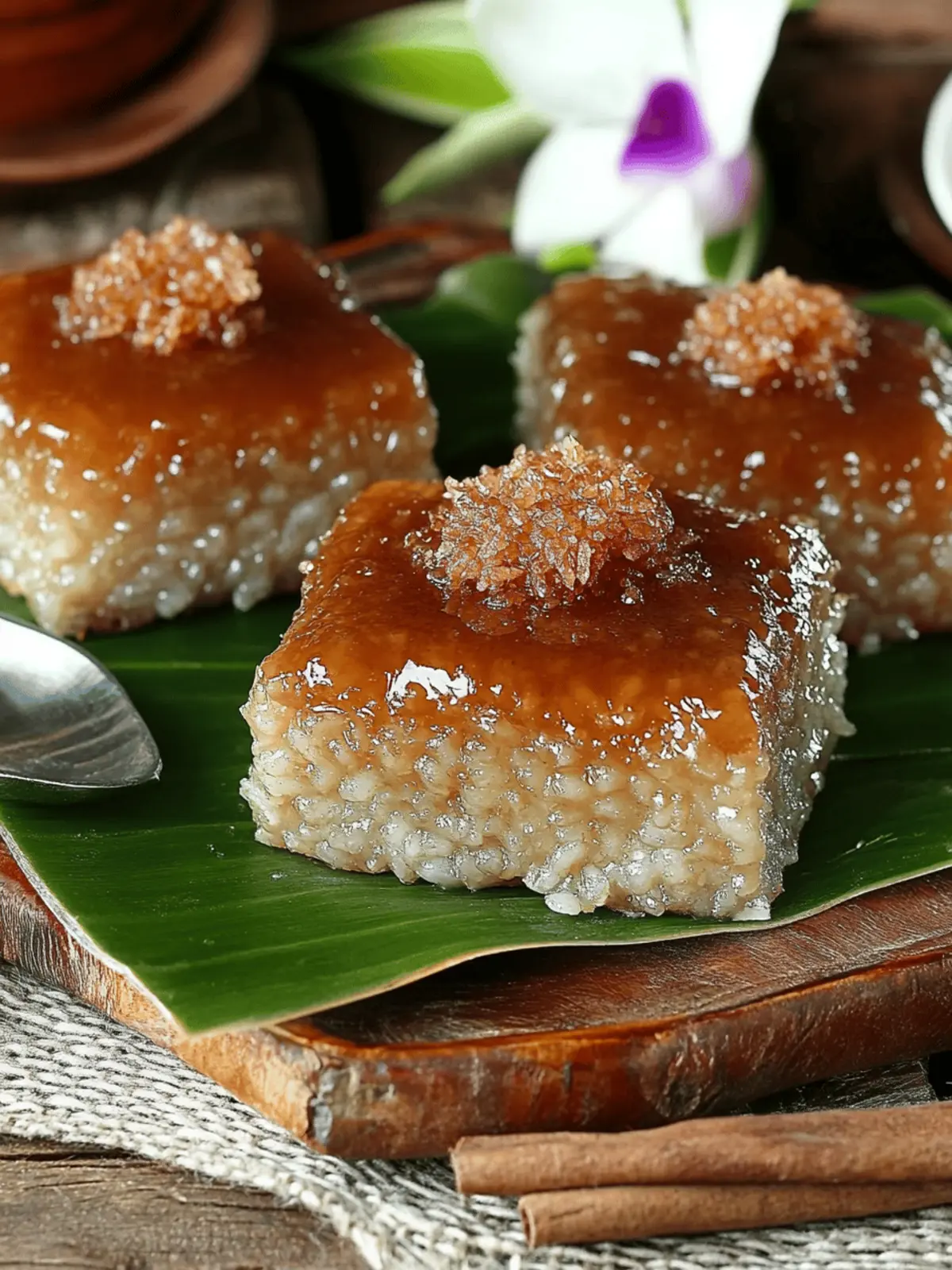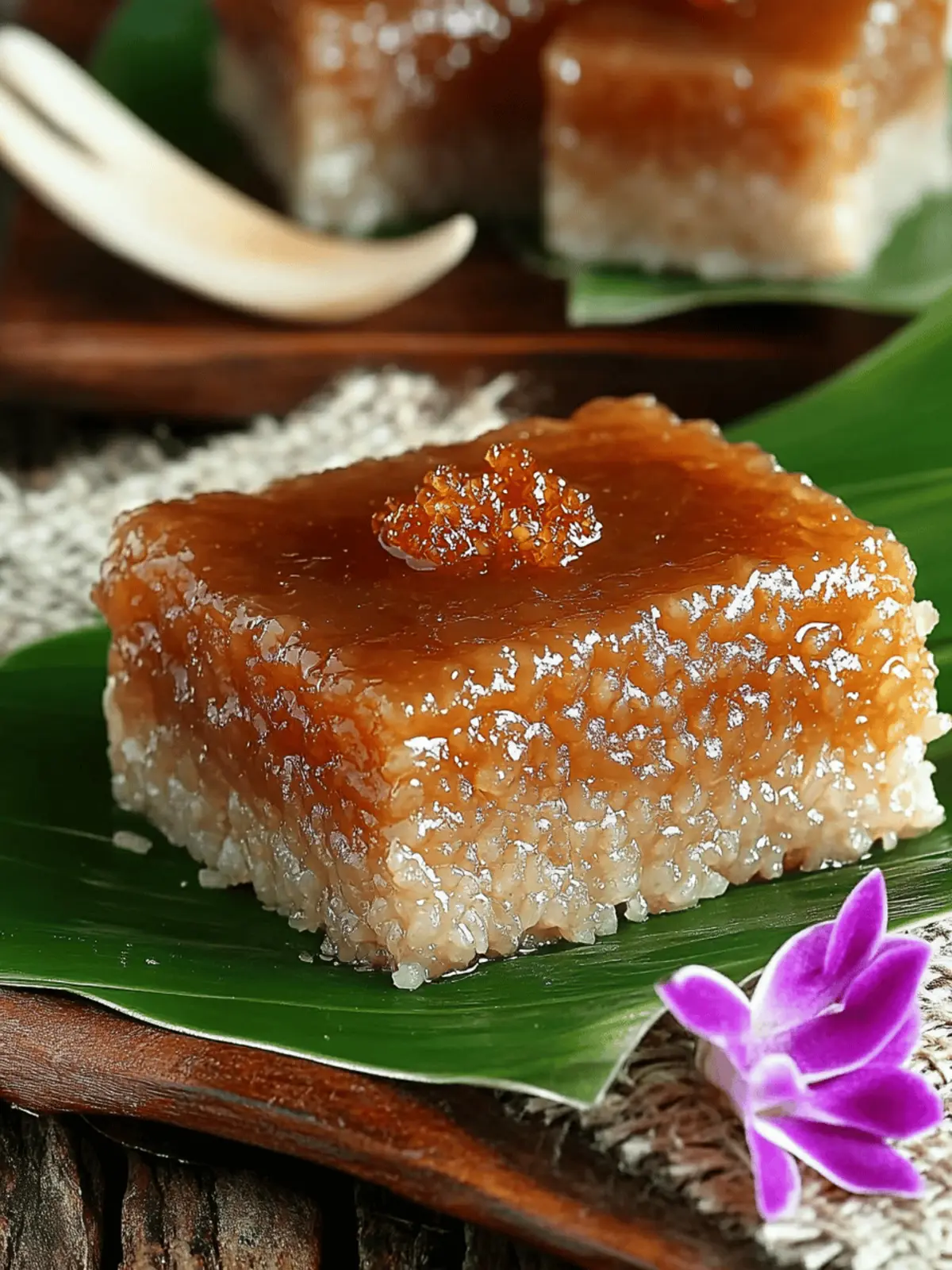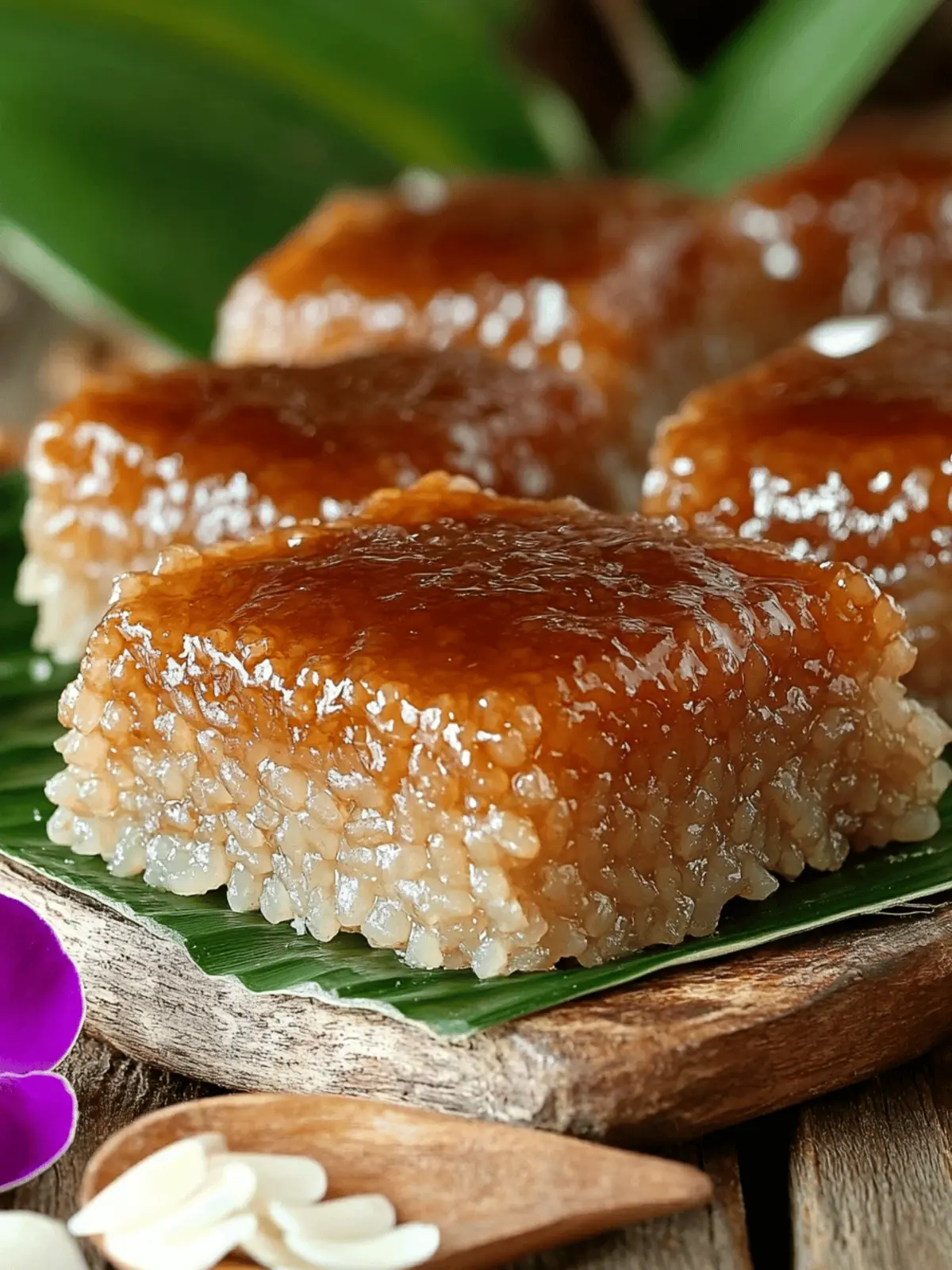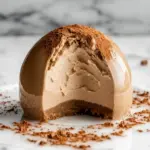When I first tasted Biko, I was completely transported to a warm Filipino kitchen, where the air was thick with the sweet aroma of coconut and brown sugar. This delightful sticky rice cake, with its rich, chewy texture, is more than just a dessert; it’s a manifestation of love and tradition. Ideal for gatherings or as a comforting snack, Biko beautifully combines the creaminess of coconut milk with the deep, caramel notes of brown sugar, creating an indulgent treat that pleases both young and old alike.
This Biko recipe is not only gluten-free but also incredibly satisfying to make. Whether you’re a seasoned chef or a home cooking enthusiast looking to explore new flavors, this dish brings warm memories to the fore while satisfying your sweet tooth. I’ve simplified the process to ensure you enjoy the simplicity and joy of creating this irresistible delicacy at home. Get ready to bring a slice of Filipino culture to your table!
Why is Biko Recipe so beloved?
Authentic Flavor: Biko embodies the essence of traditional Filipino cuisine, featuring rich coconut and deep caramel notes that create unforgettable taste experiences.
Simple Steps: With easy-to-follow instructions, you can whip up this delightful treat even if you’re new to cooking!
Perfect for Sharing: Ideal for gatherings, this dessert is sure to impress friends and family alike, making it a crowd favorite at any occasion.
Versatile Ingredients: Feel free to adapt the recipe to your liking by experimenting with different sugars or infusing it with your favorite fruits!
Comforting Delight: Each bite of Biko transports you to a cozy kitchen, filled with warmth and aroma—perfect for satisfying your sweet cravings!
Make sure to check out some expert tips we’ve included to elevate your Biko-making experience!
Biko Recipe Ingredients
For the Rice Mixture
- Glutinous Rice – Essential for that delightful chewy texture; rinse thoroughly before cooking.
- Canned Coconut Milk – Offers luxurious creaminess; opt for full-fat for the best flavor. Substitute with coconut cream for extra richness, but adjust the liquid ratio.
- Water – Balances the mixture; modify as needed based on the rice’s absorption needs.
- Pandan Leaves – Adds a fragrant aroma; while optional, they enhance authenticity—use pandan extract (1 tsp) if you’re in a pinch.
For the Latik Syrup
- Dark Brown Sugar – Brings deep sweetness and caramel richness; isn’t as sweet as light brown sugar, which can be used in a pinch.
- Vanilla Extract – Introduces warm flavor notes; it’s optional but highly recommended to enrich the syrup’s taste.
- Vegetable or Coconut Oil – Grease your baking pan for easy removal of the Biko.
Be ready to experience the delicious charm of this Biko recipe, perfect for sharing with your loved ones!
How to Make Biko
-
Prepare Rice: In a pot, combine 1 cup of coconut milk and 1 cup of water. Bring the mix to a simmer before adding the washed glutinous rice and pandan leaves. Cover and cook on low until most liquid is absorbed, leaving some grains looking slightly chalky.
-
Make Latik Syrup: In a separate pan, combine 2 cups of coconut milk with dark brown sugar and vanilla extract if using. Cook over medium heat, stirring continuously until the mixture thickens and turns a rich caramel color. Reserve ½ cup for topping later.
-
Combine Rice and Syrup: Gently fold the cooked rice into the pan with the latik syrup. Continue cooking on low heat, allowing the rice to fully absorb the syrup while ensuring it remains firm and not overly mushy.
-
Transfer to Baking Pan: Spread the mixture evenly in a greased 8×8 inch baking pan. Drizzle the reserved latik syrup on top for a delicious finish.
-
Bake: Preheat your oven to 350°F (180°C). Bake the Biko for 20-30 minutes until it’s bubbly and slightly firm to the touch.
-
Cool and Serve: Once baked, allow the Biko to cool before cutting into squares. This will help maintain its shape and rich texture.
Optional: Top with freshly grated coconut for an added layer of flavor and texture.
Exact quantities are listed in the recipe card below.
Make Ahead Options
These delightful Biko (Filipino Sticky Rice Cake) treats are perfect for meal prep enthusiasts! You can prepare the glutinous rice mixture and the latik syrup up to 24 hours in advance. Simply cook the rice and fold it into the syrup as instructed, then store the mixture in the refrigerator. Additionally, you can keep the reserved latik syrup separately in a sealed container for up to 3 days to enhance its flavors. When you’re ready to serve, just spread the rice mixture in a greased baking pan, drizzle the reserved syrup on top, and bake until bubbly. This way, you’ll enjoy restaurant-quality results with minimal effort, making your busy weeknights a little sweeter!
Expert Tips for Biko Recipe
-
Perfectly Cooked Rice: Ensure that the glutinous rice is only partially cooked before mixing with the latik; this prevents it from becoming mushy in texture.
-
Sugar Selection: Using dark brown sugar enhances the richness of your Biko; if you opt for light brown sugar, taste as you go to adjust sweetness levels.
-
Pandan Alternatives: If you can’t find pandan leaves, don’t fret! It’s optional; pandan extract can substitute, though the flavor may slightly vary.
-
Latik Cooking: Stir the latik continuously as it cooks to avoid burning and achieve that delightful caramel color crucial for your Biko.
-
Serving Temperature: For the best flavor, serve Biko warm or at room temperature; this allows the coconut caramel to shine through!
-
Storing the Dish: Although Biko is best enjoyed fresh, it can be refrigerated for a few days. Reheat gently to restore its chewy texture when servin.
How to Store and Freeze Biko
Room Temperature: Store Biko at room temperature for up to 1 day if you plan to consume it quickly. Keep covered to prevent it from drying out.
Fridge: For longer storage, refrigerate Biko in an airtight container for up to 3 days. This helps maintain freshness, but it’s best enjoyed fresh.
Freezer: Freeze Biko for up to 2 months in a well-sealed airtight container. To avoid freezer burn, wrap it tightly in plastic wrap before placing it in a container.
Reheating: To reheat, thaw overnight in the fridge, then warm in the microwave or on the stovetop, adding a splash of coconut milk to restore moisture and that delightful sticky texture. Enjoy your Biko!
Biko Recipe Variations
Customize your Biko with these delightful twists to create a truly personal treat!
-
Fruity Infusion: Add crushed ube or mashed ripe mango to the rice mixture for a burst of fruity flavor, transforming the dish into a tropical delight.
-
Nuts & Coconut Flakes: Mix in toasted cashews or unsweetened coconut flakes before baking for a crunchy texture that pairs beautifully with the sticky sweetness.
-
Coconut Sugar Twist: Swap dark brown sugar with coconut sugar for a unique, caramel-like depth that’s slightly more earthy and less refined.
-
Dairy-Free Delight: Use non-dairy coconut cream instead of canned coconut milk for an ultra-rich vegan version that retains all the traditional flavors.
-
Spiced Version: Sprinkle a pinch of cinnamon or nutmeg into the latik syrup for a warming aromatic flavor that adds a cozy twist to every bite.
-
Chili Kick: Drizzle a little chili oil over the top for a surprising heat that contrasts delightfully with the coconut’s sweetness.
It’s time to get creative! Each variation lets you explore new flavors while keeping the heart of this beloved Filipino dessert alive.
What to Serve with Biko?
Create a delightful feast that brings the rich flavors of Filipino cuisine to life.
-
Fresh Mango Slices: The sweet, juicy mango offers a refreshing contrast to the rich, sticky Biko, enhancing your overall dessert experience.
-
Coconut Flan: This creamy dessert adds a different texture while keeping the coconut theme alive. Serve a small slice alongside for a delightful pairing.
-
Filipino Barbecue Skewers: The smoky, savory flavors of the skewers balance the sweetness of Biko wonderfully, making it a perfect duet for a well-rounded meal.
-
Sweet Sticky Rice with Mung Beans: If you love rice desserts, this addition can introduce another layer of stickiness and sweetness, closely resembling the texture of Biko.
-
Strong Brewed Coffee: The robust flavor of coffee offers a perfect contrast to the sweetness of Biko, making it a great companion for dessert lovers.
-
Buko Salad: This refreshing fruit salad, accented with young coconut and cream, enhances the tropical experience, making every bite of sweet Biko even more enjoyable.
-
Tropical Fruit Smoothie: Cool and creamy, a blend of pineapple, banana, and coconut milk will accentuate the tropical vibe and cleanse your palate beautifully after enjoying Biko.
-
Halo-Halo: For a festive twist, serve Biko as part of a halo-halo dessert. Its chewy texture pairs wonderfully with the assortment of ingredients in this iconic Filipino treat.
Biko Recipe (Filipino Sticky Rice Cake) Recipe FAQs
What type of glutinous rice should I use for Biko?
For the best sticky texture, I highly recommend using sweet glutinous rice, which you can find at most Asian grocery stores. Look for packages labeled “glutinous rice” or “sweet rice.” Make sure to rinse it thoroughly before cooking to remove excess starch, which helps achieve that lovely chewy consistency.
How should I store leftover Biko?
Store leftover Biko in an airtight container in the refrigerator for up to 3 days. I encourage you to let it cool completely before placing it in the container to maintain its delightful texture. If you plan to keep it longer, refrigerating it is the way to go!
Can I freeze Biko, and how do I do it?
Absolutely! Freezing Biko is simple. Wrap it tightly in plastic wrap, ensuring there are no air pockets, and then place it in a well-sealed airtight container. It can last in the freezer for up to 2 months. When you’re ready to enjoy, simply thaw it overnight in the refrigerator before reheating.
What are some common troubleshooting tips when making Biko?
If your Biko comes out too sticky or mushy, it may be due to overcooking the glutinous rice before combining it with the latik syrup. I suggest leaving the rice slightly undercooked, allowing it to absorb the syrup without losing its structure. Also, ensure you’re cooking the latik on medium heat while stirring constantly to prevent burning!
Can pets eat Biko, and are there any allergies to consider?
While Biko is delicious for humans, it’s best to avoid giving it to pets. The sugar and coconut content can be hard on their digestive systems. As for allergies, note that Biko contains coconut and rice, which are generally safe for most, but always check for specific allergies, especially to coconut or any other ingredients you may choose to add.
How can I tell if my coconut milk is fresh enough to use?
When using canned coconut milk, always check the expiration date. Opened canned coconut milk should be used within 3 to 4 days if refrigerated. Additionally, give it a good shake; if it smells off or has an unusual texture (like a slimy consistency), it’s best to discard it and get a fresh can for your Biko!
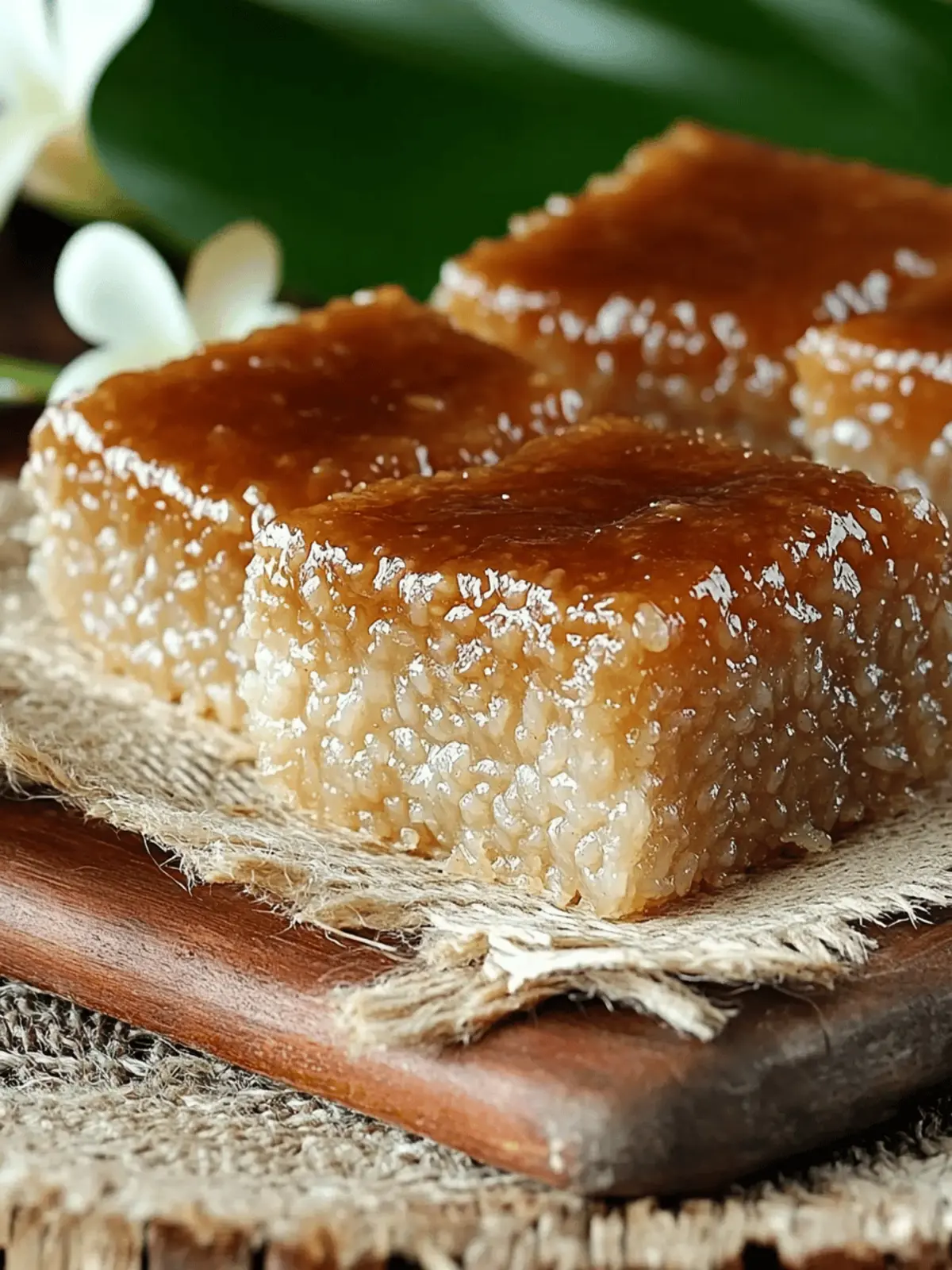
Delicious Biko Recipe: Perfectly Sticky Filipino Rice Cake
Ingredients
Equipment
Method
- In a pot, combine 1 cup of coconut milk and 1 cup of water. Bring to a simmer, then add washed glutinous rice and pandan leaves. Cover and cook on low until most liquid is absorbed.
- In a separate pan, combine 2 cups of coconut milk with dark brown sugar and vanilla extract. Cook over medium heat, stirring continuously until thickened.
- Gently fold the cooked rice into the latik syrup. Cook on low heat until rice absorbs the syrup without becoming mushy.
- Spread the mixture evenly in a greased 8x8 inch baking pan. Drizzle reserved latik syrup on top.
- Preheat the oven to 350°F (180°C). Bake for 20-30 minutes until bubbly and slightly firm.
- Allow to cool before cutting into squares.

